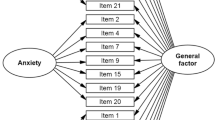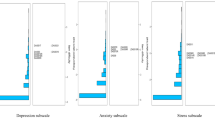Abstract
While the 21-item version of the Depression, Anxiety, and Stress Scales (DASS-21) is commonly used to measure depression, anxiety, and stress, there is emerging evidence that the DASS-21 total score can be used as a measure of distress in adolescents as well. However, little research has investigated the convergent validity of the DASS-21 as a measure of distress, and no studies have examined potential cutoffs for the DASS-21total score in adolescents. To address these gaps, the present study investigated the convergent validity of the DASS-21’s total score and determined preliminary cutoff scores that could be used to identify adolescents that are clinically distressed. After 306 high school students (mean age = 15.35) from midwestern USA high schools completed the DASS-21 and Langner Symptom Survey (LSS), a MANOVA revealed significant sex differences. In light of these differences, analyses were carried out separately for male and female adolescents. These analyses revealed that the DASS-21 total score was significantly correlated with the LSS for males (r = .80) and females (r = .76). When using adolescents’ classification on the LSS as a reference point, a cutoff score of 14 appeared to be best suited for female adolescents (sensitivity = .78; specificity = .74; AUC = .84), while a cutoff score of 17 appeared best for male adolescents (sensitivity = .72; specificity = .95, AUC = .99). These findings suggest that the DASS-21 total score demonstrates good convergent validity as a measure of distress and may be suitable for identifying adolescents that are clinically distressed. However, further validation of the present preliminary cutoff points is needed.


Similar content being viewed by others
References
American Psychiatric Association. (2013). Diagnostic and statistical manual of mental disorders (5th ed.). American Psychiatric Publishing.
Antony, M. M., Bieling, P. J., Cox, B. J., Enns, M. W., & Swinson, R. P. (1998). Psychometric properties of the 42-item and 21-item versions of the depression anxiety stress scales in clinical groups and a community sample. Psychological Assessment, 10(2), 176–181.
Batterham, P. J., Sunderland, M., Carragher, N., Calear, A. L., Mackinnon, A. J., & Slade, T. (2016). The distress Questionnaire-5: Population screener for psychological distress was more accurate than the K6/K10. Journal of Clinical Epidemiology, 71, 35–42.
Batterham, P. J., Sunderland, M., Slade, T., Calear, A. L., & Carragher, N. (2017). Assessing distress in the community: Psychometric properties and crosswalk comparison of eight measures of psychological distress. Psychological Medicine, 48(8), 1316–1324.
Bujang, M. A., & Adnan, T. H. (2016). Requirements for minimum sample size for sensitivity and specificity analysis. Journal of Clinical and Diagnostic Research: JCDR, 10(10), YE01–YE06.
Cochrane, R. (1980). A comparative evaluation of the symptom rating test and the Langner 22-item index for use in epidemiological surveys. Psychological Medicine, 10(1), 115–124.
Crawford, J. R., & Henry, J. D. (2003). The depression anxiety stress scales (DASS): Normative data and latent structure in a large non-clinical sample. British Journal of Clinical Psychology, 42(2), 111–131.
Drapeau, A., Marchand, A., & Beaulieu-Prévost, D. (2012). Epidemiology of psychological distress. In L’Abate, L. (Ed.) Mental illnesses-understanding, prediction and control, (pp. 105-106). InTech.
Handal, P. J., Gist, D., Gilner, F. H., & Searight, H. R. (1993). Preliminary validity for the Langner symptom survey and the brief symptom inventory as mass-screening instruments for adolescent adjustment. Journal of Clinical Child Psychology, 22(3), 382–386.
Hansell, S., & White, H. R. (1991). Adolescent drug use, psychological distress, and physical symptoms. Journal of Health and Social Behavior, 32, 288–301.
Henry, J. D., & Crawford, J. R. (2005). The short-form version of the depression anxiety stress scales (DASS-21): Construct validity and normative data in a large non-clinical sample. British Journal of Clinical Psychology, 44(2), 227–239.
Kessler, R. C., Berglund, P., Demler, O., Jin, R., Merikangas, K. R., & Walters, E. E. (2005). Lifetime prevalence and age-of-onset distributions of DSM-IV disorders in the National Comorbidity Survey Replication. Archives of General Psychiatry, 62(6), 593–602.
Lace, J. W., Haeberlein, K. A., & Handal, P. J. (2019). Multidimensionality of the Langner symptom survey and replication of a cutoff score in emerging adults. Psychological Reports, 122(1), 340–359.
Langner, T. S. (1962). A twenty-two item screening score of psychiatric symptoms indicating impairment. Journal of Health and Human Behavior, 3(4), 269–276.
Le, M. T. H., Tran, T. D., Holton, S., Nguyen, H. T., Wolfe, R., & Fisher, J. (2017). Reliability, convergent validity and factor structure of the DASS-21 in a sample of Vietnamese adolescents. PloS one, 12(7), e0180557.
Lindner, P., Frykheden, O., Forsström, D., Andersson, E., Ljótsson, B., Hedman, E., Andersson, G., & Carlbring, P. (2016). The Brunnsviken brief quality of life scale (BBQ): Development and psychometric evaluation. Cognitive Behaviour Therapy, 45(3), 182–195.
Lovibond, S. H., & Lovibond, P. F. (1995). Manual for the depression anxiety & stress scales (2nd ed.). Sydney: Psychology Foundation of Australia.
Moore, S. A., Dowdy, E., & Furlong, M. J. (2017). Using the depression, anxiety, stress scales–21 with US adolescents: An alternate models analysis. Journal of Psychoeducational Assessment, 35(6), 581–598.
Osman, A., Wong, J. L., Bagge, C. L., Freedenthal, S., Gutierrez, P. M., & Lozano, G. (2012). The depression anxiety stress scales—21 (DASS-21): Further examination of dimensions, scale reliability, and correlates. Journal of Clinical Psychology, 68(12), 1322–1338.
Patrick, J., Dyck, M., & Bramston, P. (2010). Depression Anxiety Stress Scale: is it valid for children and adolescents?. Journal of Clinical Psychology, 66(9), 996–1007.
Podsakoff, P. M., MacKenzie, S. B., Lee, J. Y., & Podsakoff, N. P. (2003). Common method biases in behavioral research: a critical review of the literature and recommended remedies. Journal of applied psychology, 88(5), 879.
Silva, H. A., Passos, M. H., Oliveira, V. M., Palmeira, A. C., Pitangui, A. C., & Araújo, R. C. (2016). Short version of the depression anxiety stress Scale-21 is it valid for Brazilian adolescents? Einstein (Sao Paulo, Brazil), 14(4), 486–493.
Sinclair, S. J., Siefert, C. J., Slavin-Mulford, J. M., Stein, M. B., Renna, M., & Blais, M. A. (2012). Psychometric evaluation and normative data for the depression, anxiety, and stress scales-21 (DASS-21) in a nonclinical sample of US adults. Evaluation & the Health Professions, 35(3), 259–279.
Szabó, M. (2010). The short version of the depression anxiety stress scales (DASS-21): Factor structure in a young adolescent sample. Journal of Adolescence, 33(1), 1–8.
Tait, R. J., French, D. J., & Hulse, G. K. (2003). Validity and psychometric properties of the General Health Questionnaire-12 in young Australian adolescents. Australian & New Zealand Journal of Psychiatry, 37(3), 374–381.
Tan, L. B., & Martin, G. (2016). Mind full or mindful: A report on mindfulness and psychological health in healthy adolescents. International Journal of Adolescence and Youth, 21(1), 64–74.
Taylor, R. (1990). Interpretation of the correlation coefficient: A basic review. Journal of diagnostic medical sonography, 6(1), 35–39.
Tully, P. J., Zajac, I. T., & Venning, A. J. (2009). The structure of anxiety and depression in a normative sample of younger and older Australian adolescents. Journal of Abnormal Child Psychology, 37(5), 717–726.
Willemsen, J., Markey, S., Declercq, F., & Vanheule, S. (2011). Negative emotionality in a large community sample of adolescents: The factor structure and measurement invariance of the short version of the depression anxiety stress scales (DASS-21). Stress and Health, 27(3), e120–e128.
Funding
No funding was obtained for this study.
Author information
Authors and Affiliations
Corresponding author
Ethics declarations
Conflict of Interest
The authors declare that they have no conflict interest.
Ethics Approval
All procedures performed in the study were in accordance with the ethical standards of the Saint Louis University Institutional Review Board and the 1964 Helsinki declaration and its later amendments or comparable ethical standards.
Consent to Participate
Informed consent to participate was obtained from the parents or legal guardians for all individual participants who were under 18. Written assent to participate was also obtained for individuals who were under 18, while written consent to participate was obtained from participants who were 18 or older at the time that they participated in this study.
Consent to Publish
Informed consent regarding potential publication of anonymous data collected during the study was obtained from parents or legal guardians for all individual participants who were under 18. Written assent or consent to publish was also obtained from participants, depending on whether they were under or over 18 (respectively).
Additional information
Publisher’s Note
Springer Nature remains neutral with regard to jurisdictional claims in published maps and institutional affiliations.
Rights and permissions
About this article
Cite this article
Evans, L., Haeberlein, K., Chang, A. et al. An evaluation of the convergent validity of and preliminary cutoff scores for the DASS-21 Total score as a measure of distress in adolescents. Curr Psychol 41, 4283–4290 (2022). https://doi.org/10.1007/s12144-020-00937-4
Published:
Issue Date:
DOI: https://doi.org/10.1007/s12144-020-00937-4




